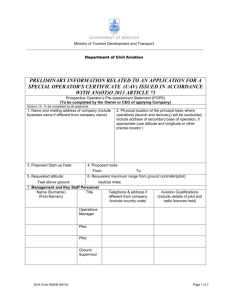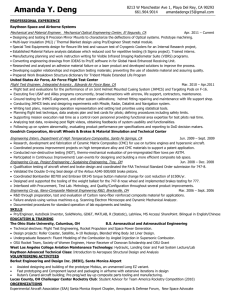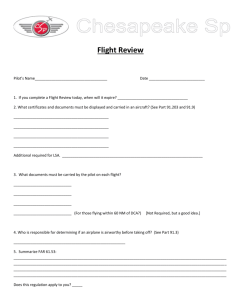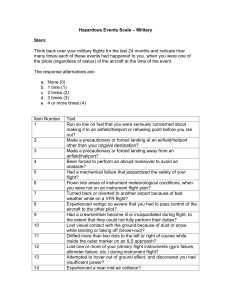in format
advertisement
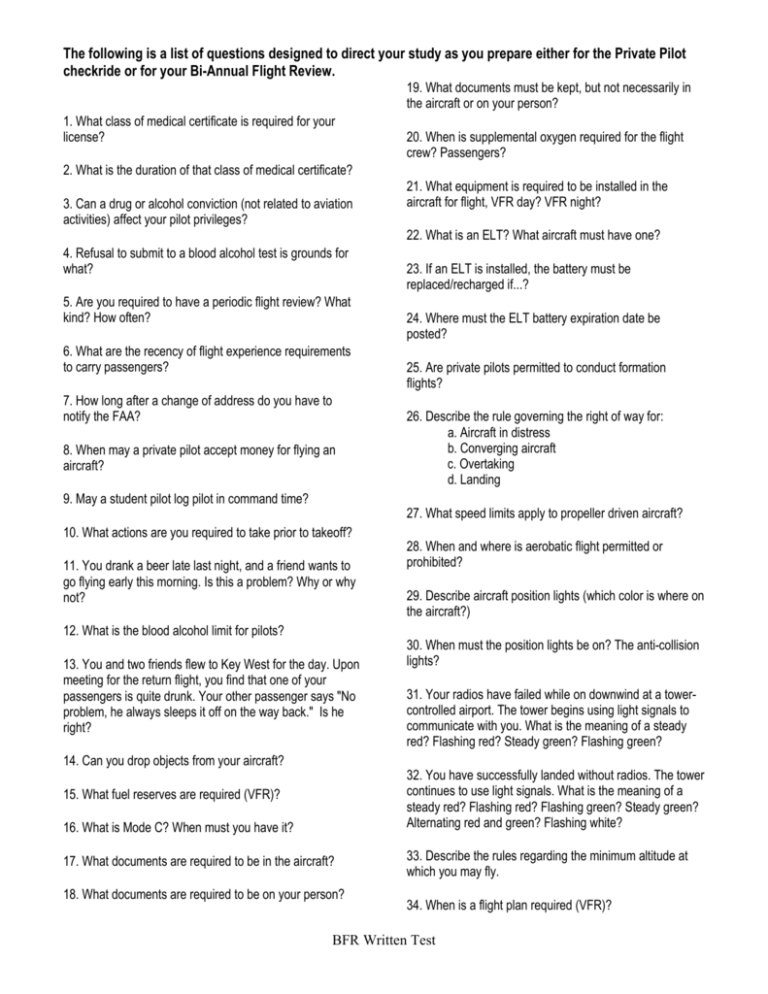
The following is a list of questions designed to direct your study as you prepare either for the Private Pilot checkride or for your Bi-Annual Flight Review. 19. What documents must be kept, but not necessarily in the aircraft or on your person? 1. What class of medical certificate is required for your license? 20. When is supplemental oxygen required for the flight crew? Passengers? 2. What is the duration of that class of medical certificate? 3. Can a drug or alcohol conviction (not related to aviation activities) affect your pilot privileges? 21. What equipment is required to be installed in the aircraft for flight, VFR day? VFR night? 22. What is an ELT? What aircraft must have one? 4. Refusal to submit to a blood alcohol test is grounds for what? 5. Are you required to have a periodic flight review? What kind? How often? 6. What are the recency of flight experience requirements to carry passengers? 7. How long after a change of address do you have to notify the FAA? 8. When may a private pilot accept money for flying an aircraft? 9. May a student pilot log pilot in command time? 23. If an ELT is installed, the battery must be replaced/recharged if...? 24. Where must the ELT battery expiration date be posted? 25. Are private pilots permitted to conduct formation flights? 26. Describe the rule governing the right of way for: a. Aircraft in distress b. Converging aircraft c. Overtaking d. Landing 27. What speed limits apply to propeller driven aircraft? 10. What actions are you required to take prior to takeoff? 11. You drank a beer late last night, and a friend wants to go flying early this morning. Is this a problem? Why or why not? 12. What is the blood alcohol limit for pilots? 13. You and two friends flew to Key West for the day. Upon meeting for the return flight, you find that one of your passengers is quite drunk. Your other passenger says "No problem, he always sleeps it off on the way back." Is he right? 14. Can you drop objects from your aircraft? 28. When and where is aerobatic flight permitted or prohibited? 29. Describe aircraft position lights (which color is where on the aircraft?) 30. When must the position lights be on? The anti-collision lights? 31. Your radios have failed while on downwind at a towercontrolled airport. The tower begins using light signals to communicate with you. What is the meaning of a steady red? Flashing red? Steady green? Flashing green? 32. You have successfully landed without radios. The tower continues to use light signals. What is the meaning of a steady red? Flashing red? Flashing green? Steady green? Alternating red and green? Flashing white? 15. What fuel reserves are required (VFR)? 16. What is Mode C? When must you have it? 17. What documents are required to be in the aircraft? 18. What documents are required to be on your person? 33. Describe the rules regarding the minimum altitude at which you may fly. 34. When is a flight plan required (VFR)? BFR Written Test The following is a list of questions designed to direct your study as you prepare either for the Private Pilot checkride or for your Bi-Annual Flight Review. 35. Define the following types of airspace; locate each on a sectional chart; describe the VFR weather minimums for operating in each; describe the equipment requirements for operating in each; describe the communications/clearances required to operate in each: Class A Class B Class C Class D Class E Class F Class G Warning Area Restricted Area Prohibited Area MOA Special Flight Rules Area VFR Corridor station? What do you as a pilot have to do to your radios to hear the Morse code identifier? 45. The FAA has found the XYZ VOR to be out of adjustment and providing dangerously inaccurate guidance. Their maintenance men are working on the station now. How can you, the pilot, tell that the signals are not reliable? 46. What is an FSS? Where can you find one on the sectional chart? What good are they to you once in flight? On what frequencies can you talk to the FSS? 47. What is Flight Watch? On what frequency? 48. What is an RCO? 49. When might you transmit to the FSS on one frequency and receive on another? 36. Are any of the requirements of 35., above, different for a student pilot as opposed to a private pilot? Recreational pilot? 37. What is special VFR? When would you use it? How do you get it? What hazards are associated with it (day, night)? 38. What are the VFR cruising altitudes? 39. What inspections are required on your aircraft? How often? Where are they recorded? 50. What is a Transcribed Weather Broadcast? Where can you listen to one? 51. What is a VHF steer? When would you want one? Who gives it to you? 52. What is radar? What does it do for you? 53. Describe VFR Flight Following: what it is, who does it, what its limitations are, how to get it. 54. Describe the following airport lighting systems: 40. Does a transponder require calibration? When? ALS VASI REIL Runway lights Taxiway lights Pilot controlled lighting Rotating beacon 41. What other devices which operate with the transponder must be calibrated? 42. Describe the ground and airborne segments of the following navigation systems, and how to use each: NDB VOR VORTAC DME LORAN 55. What does it mean if the rotating beacon is on during the day? Night? 56. What does an "X" on a runway mean? 43. Point out each of the above on a sectional chart. 57. There are two large numbers near the end of the runway. What do they mean? 44. What stations have Morse code identifiers on them? How do you find out what the identifier is for a particular 58. Describe the procedure for using each of the three VFR routes through the Los Angeles Class B airspace. BFR Written Test The following is a list of questions designed to direct your study as you prepare either for the Private Pilot checkride or for your Bi-Annual Flight Review. 59. What is an Alert area? 77. What is an ADIZ? Why do you care? 60. What is a Military Training Route? Find one on the sectional. 78. What actions can you take to get help in an emergency? 61. What is the emergency frequency? When/how do you use it? 79. The following are codes for use in your transponder. When would you use each? 1200, 1201, 7500, 7600, 7700 62. What frequency is set aside for pilots to use for air to air communications? 80. What is the NWS? 81. How do you get a preflight weather briefing? 63. You are about to enter the Class C airspace. What information should you give on the initial call? 64. You are in the Class C airspace. The controller issues you a heading and altitude which will take you through a small cloud? What should you do? 65. Describe the airport traffic pattern; which direction turns are standard; how to determine whether this airport/runway uses standard or non-standard pattern. 66. Describe the procedure for getting clearance into the Class D airspace. 67. How do you know the traffic pattern altitude at an unfamiliar airport? Runway lengths/widths? Location of hazards? Availability of services? ATIS, tower and ground frequencies? FSS telephone numbers? 68. Describe airspeeds, altitudes, gear, flap and power settings to be used on the 45, downwind, base and final. 69. Describe the procedure for a short field landing. A soft field landing. A short field takeoff, and a soft field takeoff. 70. Compare the communications requirements at tower vs. non-tower airports. 71. What is an intersection takeoff? 72. What is a NOTAM? 73. What is a position report? Is it required? Why do them? How do you do one? 83. What is a TAF? What is a METAR? 84. Winds aloft forecasts give wind in true or magnetic bearing? 85. Wind speeds are in knots or miles per hour? 86. What is ATIS? How do you get it? 87. The recording says "...temperature 54, dewpoint 52..." What does this mean to you? 88. Why do they broadcast the altimeter setting? 89. Describe the following, including implications for the private pilot: wind shear airframe icing carburetor icing induction icing clear air turbulence convective activity towering cumulus microbursts hail temperature inversion marine layer wake turbulence advection fog 90. The best course of action to take if you accidentally fly into a cloud is? 74. How do you change a flight plan in flight? 75. What is an airway? Find one on the sectional chart. 76. What is "see and avoid" mean? 82. What is an area forecast? Winds aloft forecast? 91. Describe the hazards of wingtip vortices, the conditions under which you might expect to encounter them, and how to avoid them. BFR Written Test The following is a list of questions designed to direct your study as you prepare either for the Private Pilot checkride or for your Bi-Annual Flight Review. 92. The average life span of a VFR pilot in the clouds is ? 108. Discuss density altitude 93. What is a graveyard spiral? 109. Discuss leaning procedures for your aircraft. 94. What is flicker vertigo? 110. Discuss detonation and preignition: definitions, causes, effects, relationship, and prevention. 95. What are the early symptoms of hypoxia? 111. Discuss stall characteristics of clean vs. flaps down. 96. What are the following speeds? What does each mean? What are the appropriate speeds for your aircraft? VS0 VS1 VR Vlof VX VY VA VNO VNE VFE VLO VLE 113. Do a weight and balance for today's flight. Discuss results. 114. What would you expect of an aircraft loaded beyond its CG limits? 115. Is the engine of your aircraft fuel injected or carbureted? What difference does this make? 116. Is the fuel pump required to be on or off for takeoff and landing? Vld Vref 97. What are g-forces? How are they created? How much can your aircraft take? 98. What is the relationship between angle of bank, g force, and stall speed? 99. What is an accelerated stall? 100. What does "cross-controlled" mean? 101. Define slip and skid. 102. What is adverse yaw? 103. Discuss torque, slipstream effect, and p-factor. 104. Discuss stalls and spins (definition, prevention, recognition and recovery) 105. What is Zulu time? Greenwich Mean Time? 106. Discuss airfoils, lift, and drag. 107. Compare parasite drag and induced drag 112. Discuss gyroscopic precession 117. Describe the fuel system: tanks, valves, drains, cross feeds, vents, return lines, gascolator, required fuel grades, system capacity. 118. Which direction does the CG move as fuel is burned off? 119. Is this aircraft equipped with an alternator or a generator? What difference does this make? Is it belt or gear driven? What is its capacity? 120. Is there an avionics master switch in the aircraft? Where? 121. Where are the alternator field and bus circuit breakers/fuses? 122. Does this aircraft have an over voltage protection circuit? Describe its operation including any potential "false activations." 123. Describe the use of the EGT and CHT gauges, if so equipped. 124. Describe the vacuum system. Which gyros are vacuum driven, and which are electric? 125. How does the Pitot-static system work? BFR Written Test The following is a list of questions designed to direct your study as you prepare either for the Private Pilot checkride or for your Bi-Annual Flight Review. 126. What is the rate of climb at 8000 feet pressure altitude, 90 degrees F? 127. What is the difference between a SIGMET and an AIRMET? CONVECTIVE SIGMET? 128. Ceilings are in feet; is this MSL or AGL? 129. Discuss the ceilings, visibility, cloud types and turbulence, which are to be expected in stable vs. unstable air. 130. Under what weather conditions is carburetor icing most likely? 131. How is an aircraft ignition system different than a car? 132. What is the magneto ground wire? Why is it important? 133. Compare/contrast dead reckoning, pilotage and radio navigation. 134. What are NOTAMS? 135. NOTAMS are included in the standard private pilot weather briefing: True/False? 136. Discuss the visual illusions and the typical effects on the approach path flow caused by: a. Rain b. haze c. narrower than usual runway d. wider than usual runway e. up sloping runway f. Down sloping runway 137. During a go-around, what would be the effect if a pilot were to fail to retract the flaps to the go-around setting, leaving them at the full-down position? 138. During a go-around, what would be the effect of flying the aircraft at an airspeed higher than that recommended in the go-around procedure? 139. What would be the effect if the pilot were to allow the aircraft to stall while in a full slip (as during a slip-to-landing maneuver)? BFR Written Test


